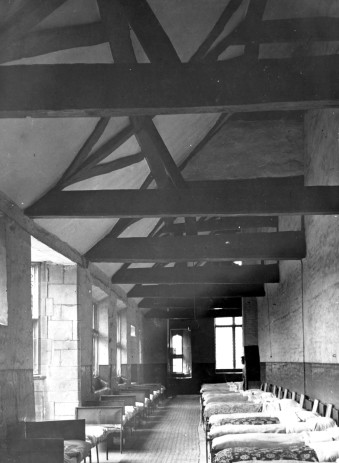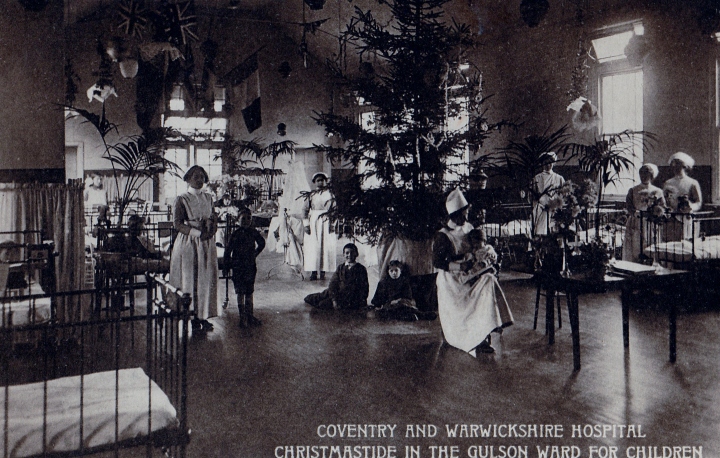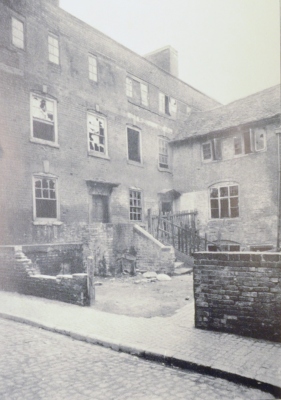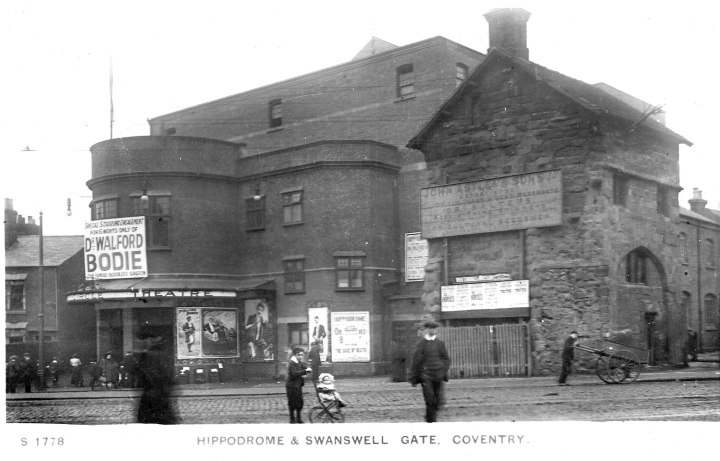The idea that Christmas in the Northern hemisphere offers a brief escape not just from the drabness of mid-winter but from the daily grind is as old as the festive season itself. The lights, the decorations, the music and the relentless advertisements showing glamour, sparkles and families having glorious fun together remind and encourage us to prepare in the best way we can for a few days in which life – for better or worse – does not feel quite the same as usual. As I walked around Coventry city centre a few days after the Christmas lights’ switch on this year, I wondered about Coventry folk doing the very same thing but a century ago. What was on their minds as they gazed at the first window displays of the season and as the first advertisements for Yuletide fayre appeared in the newspapers? Were they eagerly anticipating the holiday or wishing either that it was not happening at all or that at the very least it would be over as quickly as possible? So, for anyone who thought that I was about to deliver a sermon about the true meaning of Christmas, rest easy; instead, here is a glimpse at Coventry’s Christmas preparations in 1919, with particular focus on those struggling to make ends meet.

For the folk in need of a reminder (and I suspect there were a great many who were) that the time of good cheer was really upon them, the Midland Daily Telegraph tried to help out in the run up to Christmas. This was, it told its readers, the first Christmas since the signing of Peace; during the year, soldiers had been happily reunited with their families and, in spite of grave problems – unemployment and housing shortages to name just two – there was at last a chance for merriment ‘to percolate into dwellings which for years have been darkened by clouds of anxiety and sorrow’. The war dead were not forgotten; empty chairs in homes told of sacrifices made by those who did not return from the War and to the servicemen demobilized throughout the year, the wish for ‘Peace on earth, goodwill to men’ could have no deeper meaning. The editorial paid tribute to the ‘unselfishness and stoicism’ of brave mothers who found themselves now solely responsible for making sure that their children had a joyful Christmas. It highlighted the importance of children’s happy bliss, too young, it reckoned, to understand the serious problems of life and instead enabled to ‘enjoy the rollicking fun attached to the legendary visit of Santa Claus’.
And there were many charitable ventures intended to make sure that Christmas in Coventry that year could be enjoyed as best as possible. After the upheavals of war, the government and local authorities spent much of 1919 in anticipation of social unrest, fearing that every strike would threaten law and order and push Britain nearer to a crisis that might result in Britain going the way of Soviet Russia. So the powers that be were probably not best pleased with the sermon delivered on the Sunday before Christmas by the Christian Socialist vicar of St Peter’s Church in Hillfields. To a congregation which contained several members of the Coventry Unemployed Workers’ Committee, the Reverend Paul Stacy declared that, broadly speaking, the Russian Revolution had ‘revealed God’s justice as against capitalism, which was a modern Anti-Christ’. He then said that God was undoubtedly at work in the labour movement, calling upon all to work together to build a fairer, better order. Far less challenging than this were the Midland Daily Telegraph’s numerous December messages embracing the spirit of the season, almost implying that to do so was something of a public duty, exhorting all to cast troubles aside and surrender to the reassuring traditionalism of Christmas. Yes, admitted the editorials, there was distress but food was plentiful and although prices were high, they were not exorbitant. Maybe so, but amidst the adverts for gifts, dancing, pantomime and cinema (all of which I will return to, so do hang on if you want to know what else was out there beyond the misery), were notices and articles of charitable endeavours and institutional obligations to help as many citizens as possible.
Thanks to a committee set up by Coventry City Council, war widows and their dependants were entitled to parcels containing one or more plum puddings, six to twelve mince pies, two fruit cakes, a pound of tea, a pot of jam and – for large families only – a joint of meat. Ex-servicemen were presented with an illuminated card on which was recorded the grateful appreciation of the city for their patriotism in serving King and Country in the Great War, ‘with honour, in a just and righteous cause’. The cards came with a box containing 50 cigarettes given to ‘a gallant Townsman’. To what extent food hampers and civic gifts compensated for the enormous sacrifices made by the city’s families can only be guessed at, but they were at least acknowledgements of duty done and suffering endured. In addition, businesses and individuals contributed to the Mayor’s Fund for Relief, which offered help to those who applied in wards across the city. The list of contributors printed just before Christmas ranged from £100 from industries including Rudge Whitworth and Triumph to six shillings donated by a group of schoolgirls.
In the months following the war, as factories reverted to peacetime production, many industries experienced something of a boom as orders picked up and trade adapted to new conditions. Despite this, however, even before an economic slump took hold in 1920, unemployment in Coventry was uncomfortably high in December 1919 and the local press noted with regret that this was the one circumstance likely to lessen the full observance of the festive season. Despite deliberately protracted demobilization throughout the year, not all ex-servicemen had moved seamlessly into employment and women continued to be affected not just by the closure of munitions’ factories but by the determination of many industries to be rid of as many women workers as possible. Hardship had been exacerbated by the recent withdrawal of the temporary unemployment benefit granted by the Government in November 1918, leading some of the city’s newest Labour councillors to urge both Government and Council to provide alternative means of sustenance to those in the direst need.
According to the Unemployed Workers’ Committee, there were up to 9000 unemployed men and women in Coventry (of a total population of around 136,000). Families had long since run out of savings and many had no choice but to apply to the Board of Guardians for assistance. The Guardians, noting that the numbers being helped were considerably higher than in the previous year, expressed their especial regret that ‘respectable’ men and women, together with their children, should find themselves destitute at Christmas. Much of the help given was in the form of food with only a limited amount of cash relief available. It was therefore acknowledged that for some there was no alternative but a humiliating admission to the Workhouse.

Here, for resident children, there was a collection of toys and hope that a Christmas tree would be provided. On Christmas Eve the 420 inmates (some of whom were in the workhouse infirmary) received a visit from the Mayor and his family and presents of tea, sugar and tobacco were distributed. Lunch of roast beef, vegetables and plum pudding was served at midday on Christmas Day, with an ‘allowance’ of beer, or sweets and ‘other luxuries’ for those who preferred these. Those children removed from the workhouse to ‘scattered homes’ (increasingly regarded as kinder, less institutional surroundings for young people than the workhouse) run by the Poor Law Union in Hill Street, Whitley and Edgwick were also treated to festive food, toys and entertainments. For families who were able to stay together in their own homes, the education authority made sure that meals for children in need were available at the Municipal Restaurant in Ford Street, which had been set up during the war.

If all this wasn’t enough, Coventry was also facing a housing crisis. There was too little working class housing, a great deal of overcrowding (with many couples and even families crammed into one or two rooms in lodgings) and unacceptable levels of insanitary and inadequate accommodation. Building materials were in short supply, leaving those willing to work in construction unemployed. The Medical Officer for Health confirmed that in 1919 building fell to its lowest levels for 20 years, with just 125 houses completed, compared to 1,491 during the war years. Even with the addition of these, built for war workers, there was reckoned to be a shortage of over 2000 homes in the city. As a temporary measure, the Council started to convert former munitions’ workers’ hostels into cottages, although there was considerable disquiet about the high price of the rents being charged for such small dwellings, particularly as they were often inadequate or ill-suited to family needs. These were, as was often pointed out with bitterness, a long way from the homes for heroes promised to returning soldiers by Prime Minister David Lloyd George (Coventry’s housing provision did expand in the years to come). Paying over-inflated rent and keeping the landlord at bay was a constant worry for many families, as Labour councillor Alice Arnold reminded a magistrate who was hearing the case of an ex-solider facing eviction. Councillor Arnold lost patience in the courtroom and expressed her frustration with a system she believed was biased against working class men and women. She left the court with the tenant declaring that she intended ‘to make such a stink of it in Coventry that I will make the magistrates who heard the case ashamed of themselves.

So, as in any year before and since 1919, many of those who came into the city centre to get ready for Christmas were facing enormous challenges and try as they might, they could not ignore the seasonal transformation of shop windows and the shelves stacked with seasonal gifts. Food, good health, employment, decent housing and the chance to be distracted from the worries of everyday life were modest requirements as the season approached.
Advertising was as artful then as now; Kendalls of Broadgate, for example, informed potential customers that,
No real harm can come to England while the Christmas spirit lives – that sympathy with fellow men which makes us wondrous kind. Christmas Gifts prove this! What Presents could be more ‘thoughtful’ than beautiful rain-resisting Umbrellas, real Kendalls.
In contrast, the Broadgate offices of Albert E Hunt were also on hand, reminding Coventry people that the problems of the War were over but that now new conditions confronted everyone. If by chance any citizens should need ‘cash accommodation’ to put their affairs in order, they could do no better than to apply for advances from Hunt’s business of between £10 and £5000. Armed with a loan and a nice fat debt with which to start the New Year, parents could then visit Fletchers at 24, West Orchard, to see its array of toys, or the books and fancy goods on sale at Ward’s at 11, Broadgate. Some might even consider taking the children to visit Birmingham’s Toy Fair, where Father Christmas was always in attendance and the piece de resistance in 1919 was a spectacular panorama of Robinson Crusoe’s Hut with Shipwreck in the distance, Cannibal Encampment complete with jungle, moving animals and rustic bridges crossing streams from a ‘real waterfall’.
B Riley Taylor, Outfitter at Kings Head Buildings (at the junction of Hertford Street and Smithford Street), reckoned to stock the perfect presents for gentlemen, including gloves, silk handkerchiefs, scarves, ties, shirts and underwear. WF Webbs’ shop on Paynes Lane boasted that it had the largest stock of gramophones and records in the district, catering for all tastes, including grand opera, instrumental, musical comedy and popular songs. For the ladies who wanted to attend one or more of the many dances advertised in the local press, Newton’s Fancy Drapers, with stores on both Hertford Street and the Foleshill Road, was on hand for Paris net dance frocks, prettily trimmed and finished with either Crepe de Chine or Tinsel Tissue. Younger girls could plead with their mothers for party frocks of white spotted net daintily trimmed and fully lined. Mrs Penny of Brooklyn Road, Foleshill, catered for those attending fancy dress balls, hiring costumes at moderate charges.

Hopefully Mrs Penny’s trade boomed just before the Christmas Eve fancy dress ball at the Baths Assembly Hall, with dancing from 7 to 12 and licensed refreshments for sale. For less energetic revellers, Coventry had an array of venues showing films, plays and musical evenings to suit a range of tastes over the festive season. On Boxing Day, a new ‘picturisation’ of Louisa Alcott’s popular novel, Little Women, was scheduled to run for two nights at the Globe on Primrose Hill Street. Amongst advertisements for films including ‘The Temple of Dust’, ‘The Hope Chest’, ‘When a Woman Sins (in 7 parts) and ‘Jazzmania’ at the Empire (a film exhibition of modern ballroom dancing for those wishing to try out their new steps over Christmas), it was ‘Little Women’ which leapt out at me as I looked through the newspapers, because I am eagerly awaiting a new version of the film, which opens on Boxing Day 2019.

Family fun was to be found at the Opera House where Dick Whittington and His Cat, complete with full orchestra and large opera chorus began a weel’s run on Boxing Day. Football fans could escape to the Christmas morning match (thus avoiding involvement in the preparation of Christmas lunch, apart from getting home in time to carve the meat) to see second division Coventry take on Stoke, with another game on Boxing Day (Hednesford Town) and West Bromwich Albion the day after. Both traditions remain strong 100 years on, with a few notable changes; this year Puss in Boots is the Belgrade Theatre’s pantomime and although there are no longer Christmas Day football fixtures, there are normally Boxing Day ones – Coventry was scheduled to play Bury, a club that has sadly gone out of business this season – and so the Sky Blues won’t play until they travel to play Wycombe Wanderers on December 29th.
To stock the cupboards and the pantry, the Coventry markets were open from 8 to 10pm on Christmas Eve. Blythe and Sons in the Market Place warned customers that although turkey and geese were in short supply, they were of a quality far superior than was obtained during the War. There were plenty of fowl and chickens, pork was harder to obtain than beef at butchers’ such as the London Central Meat Company Ltd, which had shops in many towns and cities. On the High Street, Atkins and Turtons had currants, sultanas, mincemeat, nuts, ‘pure confectionery’, chocolates and biscuits, including Tom Smith’s Crackers. There was a good supply of dessert fruit, including oranges (which had been hard to get during the War), lemons and apples. In many shop displays, the Christmas cake was a very welcome sight after its general absence due to wartime rationing and food shortages. Chocolate was a popular treat with Rowntrees advertising a ‘plain eating chocolate, with a piquant biscuit-like “snap” and it melts in the mouth with velvety smoothness’ whilst ‘of course Christmastide without a glorious steaming cup of Rowntree’s elect cocoa is unthinkable’.
Families did what they could, took what work they could find in order to provide for their children, swallowed their pride if they needed to, in order to accept charity or poor relief. Before the birth of the welfare state, safety nets were even less robust than today; unemployment benefit was time limited after which there was only parish (poor) relief or charity to turn to. Peace had returned to the nation but for millions of people, life was far from stable. I suspect that despite uncertainty and anxieties about the coming year, there were many people willing to trust that Christmas entertainments might be distracting and healing and to suspend normal life for a day or two at least. On Christmas Eve the Midland Daily Telegraph observed that Coventry ‘in pleasure is indeed a strange contrast to the city during the strenuous days of the past five years’. In an editorial that was almost sermon-like in tone, readers were urged to put away their cares and troubles, their strife and discontent and to let Christmas 1919 be the harbinger of social and industrial peace. Please, it seemed to urge, unite and look after one another and,
As the Christmas bells peal out and the carols are sung with all the verve at the command of the songsters, the homes will assume an atmosphere of jovial conviviality.
And for all those for whom this was an impossibility, there was always next year.
Author copyright Cathy Hunt
With thanks to the British Newspaper Archive. Material and quotes from Midland Daily Telegraph, Coventry Standard and Coventry Herald
Photos courtesy of David Fry.
I read it!!!!!
Another excellent piece!!!!
Rachel Field
07704 675775
http://www.fieldwork.me.uk
LikeLike
Thanks Rachel. Glad you enjoyed it!
LikeLike
Very interesting, the authorities were very fearful of revolution at that time. The dreaded workhouse still haunted people, a bit like benefit sanctions and the street beckons those of us unfortunate enough not to be able to work today.
In a hundred years time will we look to today’s Coventry Telegraph to get a picture of everyday life in the city? Probably not. So where would you look for information about today’s concerns and issues?
LikeLike
Thank you so much for your feedback and comments. It’s a very interesting point you make about future sources of information for historians as the nature of local press changes. All the more important that we talk to people, record their thoughts and experiences and not lose or ignore valuable social history.
LikeLike